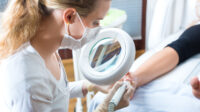By Megan Hom, Samuel Merritt University (California School of Podiatric Medicine)
Studying for any large standardized test can be a daunting task, and the APMLE Part 1 is no different. It is considered by many as the most challenging exam of the three-part APMLE tests that podiatry students are required to take, with an average pass rate of 85 as of 2022.
Since it covers almost all of the material you have learned your first two years of podiatry school, figuring out what to focus on can be difficult. That said, it is a completely feasible exam if you work hard and know what to invest your time in.
Here are five tips that I found helpful while preparing for the APMLE Part 1.
1. Focus on the “Big Three”
The APMLE Part 1 covers General Anatomy (which includes Histology and Neurology), Biochemistry, Microbiology, Pharmacology, Physiology, Pathology and Lower Extremity Anatomy. This is a TON of information and you can’t know everything (no matter how hard you try).
But not to worry! You do not need to know every single thing about every subject. When I was studying, I focused a majority of my time on what many upperclassmen told me was the “Big Three.” This referred to Lower Extremity Anatomy, Microbiology, and Pharmacology.
These are the subjects most heavily weighted on the exam, so if you are able to know these topics extremely well, you will have most of the exam covered. This does not mean you need to ignore the other subjects completely, but you don’t need to cover every single part of the rest of the topics. For example, for human anatomy I would study the bigger subsets such as the brachial plexus, cardiac, and respiratory anatomy.
2. Make a Study Schedule
Depending upon your rotation schedule, it is important to form some sort of study schedule. It doesn’t need to be incredibly strict, but having a weekly goal helps keep you in check and makes sure you’re making progress.
This is particularly helpful if you have to balance rotations and studying. I was fortunate to have the month of May off before starting rotations again in June so I maximized the time I had by formulating a schedule. If you have a whole month off, or even just a few days off, I would recommend splitting your day in half between two subjects.
For example, during my month off, I would study lower extremity anatomy in the mornings and microbiology in the afternoons for a week. I would also reserve the weekends for review, to reinforce what I had covered that week.
By breaking up your time into subject blocks, you can make sure you cover everything you need to in an appropriate amount of time, as well as make studying seem a little less daunting.
3. Don’t Burn Yourself Out
While it’s inevitable that you will eventually tire of studying, there are ways to prevent you from completely burning out, which goes hand in hand with making yourself a study schedule.
The biggest advice I can give to avoid burning out is this: don’t start out studying too strong too early. You want to make sure you peak with your studying about a month before the boards, and not before.
Make sure to set aside a day or at least an afternoon on the weekend as downtime. Get outside, hang out with friends, watch Netflix, do anything that is unrelated to studying for boards or you will drive yourself crazy. Along with that, make sure to give yourself breaks throughout the day if you have no rotations to worry about.
A good method of studying that worked for me was to study hard for 45 minutes, then give myself a 15-minute break. The human brain can only focus for so long and for me, 45 minutes was just about as long as I could study before getting distracted. If you have to balance rotations with studying, you obviously won’t have as much leisure time, but I still believe the 45:15 minute work to rest ratio is still useful to minimize distractions.
4. Don’t Overdo it with the Study Sources
Unfortunately, there are very few study sources specific to APMLE Part I out there so it is inevitable that you will have to consult separate sources of information. However, you shouldn’t go overboard.
I would definitely invest in a USMLE Step 1 study book, as it covers all of the subjects you will need to know in detail. I would also use a separate lower extremity anatomy study source, such as material from lecture, since this is the subject you need to know in the most detail.
Lastly, investing in a good APMLE Part 1 question bank can help you actively review material. BoardVitals is one of the few APMLE Part I specific question banks out there, and questions are written by podiatrists and recent podiatry students for podiatry students. I wouldn’t look into using too many other study sources than what I have mentioned above, as having too many things to get through will only serve to further overwhelm you.
5. Consult Your Upperclassmen
Another great source is to consult your upperclassmen. All of the advice I’m passing along are things I learned from my conversations with upperclassmen, and I would suggest you do the same. Get as many opinions as you can and see what works for you. While you don’t need to necessarily start studying excessively early, it is never too early to start gathering information about the APMLE Part I. The more you know, the less stressful it will be.
Obviously, these aren’t the only things to keep in mind when studying for the APMLE Part I, but it should give you a strong starting point. Best of luck!




